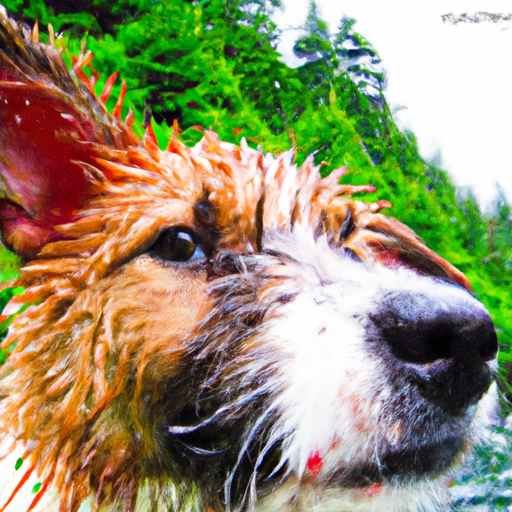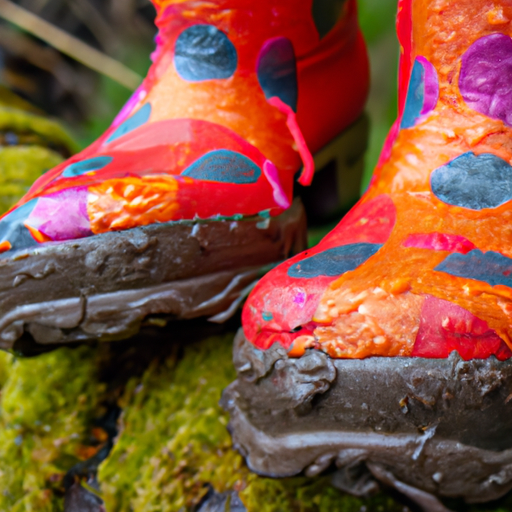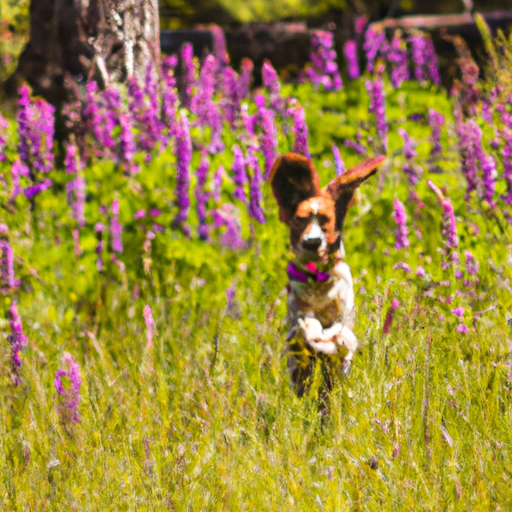Are you a running enthusiast looking for a way to add some excitement and companionship to your daily routine? Look no further than trail running with your dog! Unleashing Adventure: Trail Running with Your Dog explores the thrilling world of hitting the trails with your furry companion. Discover the benefits of this dynamic duo activity and how it can enhance your fitness journey while creating an unbreakable bond with your loyal four-legged friend. Lace up your shoes and grab your leash, because this article is sure to inspire you to explore the great outdoors with your canine companion!
Benefits of Trail Running with Your Dog
Trail running is a fantastic way to not only improve your own physical fitness but also to provide your furry friend with exercise and mental stimulation. When you hit the trails with your dog, you both reap the benefits of a full-body workout. As you navigate the rugged terrain, you'll engage your muscles, improve cardiovascular endurance, and burn calories. Similarly, your dog will also enjoy the opportunity to release pent-up energy, maintain a healthy weight, and strengthen their muscles. By embarking on trail running adventures together, you will strengthen the bond between you and your dog, creating unforgettable memories along the way.
Physical exercise for both you and your dog
One of the most obvious benefits of trail running with your dog is the physical exercise it provides. Running on trails involves navigating uneven terrain, climbing hills, and dealing with obstacles such as rocks and tree roots. These challenges engage more muscles compared to running on a flat surface, providing a more intense workout for you and your dog. The varied terrain also helps to improve balance, coordination, and agility for both of you. So lace up your shoes and hit the trails for a fun and invigorating workout session with your furry running partner.
Strengthening the bond between you and your dog
Trail running with your dog is an excellent way to foster a stronger bond between you and your furry companion. Spending quality time together, experiencing new adventures, and working through challenges as a team can deepen your connection. In the great outdoors, you'll have the opportunity to observe your dog's instincts, behavior, and reactions to different environments. This shared experience and understanding build trust and mutual respect. Your dog will learn to rely on you for guidance and support, enhancing the bond you share.
Mental stimulation for your dog
Physical exercise is not the only benefit of trail running for your dog. The sights, sounds, and smells of nature provide a wealth of mental stimulation, which is crucial for their overall well-being. The trail offers a sensory overload that engages their mind, sparks curiosity, and keeps them mentally alert. Dogs can explore their natural instincts, such as sniffing the ground, tracking scents, and spotting wildlife. Mental stimulation is just as important as physical exercise, helping to prevent boredom, anxiety, and destructive behavior in your furry friend.
Improved obedience and training opportunities
Trail running provides an excellent platform to work on obedience training with your dog. Amidst the excitement and distractions of the trail, you'll have the opportunity to reinforce basic commands such as sit, stay, and come. The increased physical and mental stimulation on the trail can also improve your dog's focus and responsiveness. By consistently incorporating training into your trail runs, you'll not only enhance your dog's obedience but also strengthen their overall discipline and self-control, making them a well-behaved companion both on and off the trail.
Preparing for Trail Running
Consulting with your veterinarian
Before embarking on a trail running adventure with your dog, it is vital to consult with your veterinarian. They will assess your dog's overall health, fitness level, and any specific conditions or concerns that may require attention. Your vet can advise you on the appropriate distance, terrain, and intensity for your dog's age, breed, and size. They can also ensure that your dog is up to date on vaccinations and parasite prevention. Consulting with your veterinarian is the first step towards a safe and enjoyable trail running experience for both you and your furry friend.
Ensuring your dog is physically fit
Trail running can be demanding on your dog's body, so it is crucial to ensure they are physically fit before hitting the trails. Like humans, dogs need adequate cardiovascular conditioning and muscle strength to handle the challenges of trail running. Engage in regular exercise routines that gradually increase in intensity and duration to prepare your dog's body for the demands of trail running. If you're unsure about your dog's fitness level, consult with your veterinarian or a professional dog trainer to develop a conditioning plan suitable for your dog's age, breed, and individual needs.
Choosing appropriate trails
When selecting trails for your trail running adventures, consider factors such as terrain, distance, difficulty level, and regulations regarding dogs. Start with beginner-friendly trails that offer a mix of surfaces, including packed dirt, gravel, and grass, to acclimate your dog to different terrains. Gradually progress to more challenging trails as your dog becomes more experienced and physically fit. It's also crucial to research and respect leash laws on each trail, ensuring the safety of both your dog and any other trail users.
Investing in proper gear and equipment
To make the most of your trail running experience with your dog, invest in appropriate gear and equipment. One of the most essential items is a well-fitting harness that provides comfort, security, and control during your runs. Consider a harness specifically designed for running to prevent chafing and ensure proper support. Additionally, invest in a sturdy, retractable leash that allows freedom of movement and gives you control when needed. Other items to consider include a lightweight and breathable vest or backpack for your dog to carry essentials, such as water and snacks, and proper footwear for yourself to enhance stability and grip on the trail.
Introducing your dog to trail running gradually
As with any new activity, it's important to introduce your dog to trail running gradually. Start with short and relaxed walks on trails, allowing your dog to explore and become familiar with the environment. Gradually increase the duration and intensity of your runs, giving your dog time to build endurance and adapt to the challenges of trail running. Pay attention to your dog's body language and adjust the pace accordingly. Patience, consistency, and positive reinforcement will help your dog develop confidence and enjoy the trail running experience.
Training Your Dog for Trail Running
Basic obedience commands
Before hitting the trails, ensure your dog has a solid foundation in basic obedience commands. Commands such as sit, stay, come, and leave it are invaluable for off-leash control and managing potential hazards on the trail. Consistency and positive reinforcement are key when reinforcing obedience commands. Practice these commands in various environments and gradually introduce distractions to improve your dog's response in real-life trail running scenarios.
Heel and loose leash walking
Mastering the heel and loose leash walking commands is essential for a pleasant and safe trail running experience. These commands allow you to maintain control and prevent your dog from getting tangled in obstacles or veering off the trail unexpectedly. Practice walking with a loose leash in various environments, gradually increasing the pace to simulate trail running. Reinforce the desired behavior with treats or praise, and be patient as your dog learns to walk calmly and attentively by your side.
Recall and voice commands
A strong recall command is crucial when trail running with your dog, especially in off-leash areas. Train your dog to come when called reliably, even in the presence of distractions. Use a positive and enthusiastic tone of voice, and reward your dog with treats, praise, or toys when they respond promptly. Practicing recall in different environments and gradually increasing the distance will strengthen your dog's response and ensure their safety on the trail.
Trail etiquette and socialization
Trail etiquette is important to ensure a pleasant experience for both you and other trail users. Teach your dog appropriate manners when encountering other runners, hikers, or animals on the trail. Reinforce commands such as “leave it” or “behind” to prevent your dog from approaching other trail users without permission. Socialization is also key to help your dog interact calmly and confidently with other dogs and animals they may encounter on the trail. Take the time to expose your dog to various situations and provide positive experiences to build their social skills.
Adapting to different terrains and obstacles
Trail running often involves navigating various terrains and obstacles, such as rocks, tree roots, and water crossings. Gradually introduce your dog to these different elements, allowing them to become comfortable with the challenges they may encounter on the trail. Practice obstacle negotiation and train your dog to navigate over or around common trail obstacles. This training will improve your dog's confidence and keep them safe as you tackle diverse terrains together.
Safety Considerations
Leashing your dog and using appropriate equipment
When trail running with your dog, it is essential to leash them and use appropriate equipment for their safety and the safety of others. While some trails may allow off-leash running in designated areas, always be mindful of leash laws and trail regulations. Even in off-leash areas, it's crucial to have a reliable recall command and keep your dog under control when encountering other trail users, wildlife, or potential hazards. Invest in a secure and comfortable harness along with a durable leash to ensure proper control and prevent your dog from pulling or escaping.
Monitoring environmental conditions
Before hitting the trails, it's essential to monitor environmental conditions for the safety and well-being of your dog. Extreme heat, cold, or humidity can pose risks to your dog's health. Check the weather forecast and plan your runs accordingly, avoiding peak temperatures or severe weather conditions. Additionally, be aware of any potential hazards on the trail such as toxic plants, wildlife, or challenging terrains that may impact your dog's safety. Stay vigilant and make informed decisions to protect your furry companion.
Recognizing signs of fatigue, stress, and injury
During your trail runs, pay close attention to your dog for signs of fatigue, stress, or injury. Dogs may push themselves to keep up with their human companions, so it's important to be mindful of their physical limitations. Watch for excessive panting, lagging behind, slowing down, or unusual changes in behavior. These can be signs that your dog is tired and in need of a break or that they may have sustained an injury. Listen to your dog's cues and take necessary rest breaks or seek veterinary attention if needed.
Providing enough water and rest breaks
Hydration is crucial for both you and your dog during trail running. Ensure you carry enough water for both of you, considering the duration and intensity of the run, as well as the ambient temperature. Dogs may not anticipate their own thirst, so encourage them to drink regularly by offering water at rest breaks. Plan your route to include opportunities for your dog to cool down and rest in shaded areas. Rest breaks give your dog a chance to recover, hydrate, and prevent them from overheating or becoming overly fatigued.
Dealing with wildlife encounters and hazards
When hitting the trails, it's important to be prepared for potential wildlife encounters and other hazards. Be aware of local wildlife that may pose a threat to your dog, such as snakes or predatory animals. Keep your dog close and under control in areas where encounters are more likely. Additionally, be cautious of hazards on the trail such as sharp rocks, thorns, or toxic plants that may injure your dog's paws or pose health risks. Stay informed about the local flora and fauna to ensure a safe and enjoyable trail running experience for both you and your fur baby.
Tips for a Successful Trail Run
Planning your route and informing others
Before setting out on a trail run, it's essential to plan your route and share it with someone you trust. Familiarize yourself with the trail map, distance, and potential challenges. Inform a family member, friend, or neighbor about your intended route, estimated duration, and expected time of return. This ensures that someone knows your whereabouts and can initiate search and rescue procedures if necessary. Additionally, consider carrying a cell phone or GPS device for added safety and communication.
Warming up and stretching before the run
Just like humans, dogs benefit from a warm-up and stretching routine before hitting the trails. Start with a brisk walk or jog to elevate your dog's heart rate and loosen their muscles. Following the warm-up, engage in gentle stretching exercises to promote flexibility and range of motion. Focus on stretching the major muscle groups, such as the legs, hips, and shoulders. Warming up and stretching can help prevent muscle strain and prepare your dog's body for the physical demands of trail running.
Using positive reinforcement and rewards
Positive reinforcement is key when training and motivating your dog during trail runs. Use treats, praise, or toys to reward desired behaviors such as staying close, responding promptly to commands, or navigating obstacles correctly. Positive reinforcement creates a positive association with the trail running experience and encourages your dog to repeat these behaviors. Celebrate their progress and make the runs enjoyable by incorporating play and interactive games during breaks or after completing a successful run.
Managing your dog's energy and excitement
Dogs tend to get excited and full of energy when hitting the trails. To maintain control and prevent excessive pulling or erratic behavior, it's important to manage your dog's energy levels. Engage in mental exercises or games before the run to help your dog burn off excess energy. Teach your dog self-control exercises, such as “wait” or “leave it,” to manage their excitement and maintain focus during the run. By channeling their energy in a controlled manner, you can ensure a safer and more enjoyable trail running experience.
Taking breaks and assessing your dog's condition
Regular breaks during trail runs allow your dog to rest, hydrate, and recover from physical exertion. Take the opportunity to assess your dog's condition during these breaks. Check the condition of their paws for any signs of injury or discomfort, monitor their hydration levels and overall behavior, and ensure they are not exhibiting signs of fatigue or stress. Adjust your pace, distance, or duration if needed to ensure the well-being and comfort of your furry running partner.
Nutrition and Hydration
Feeding your dog before and after the run
Proper nutrition plays a vital role in your dog's energy levels, performance, and overall health during trail running. Ensure your dog's meals are balanced, containing high-quality protein, healthy fats, and a variety of vegetables. Feed your dog a few hours before the run to allow for digestion. Avoid feeding your dog immediately before or after the run, as this can lead to discomfort or potentially dangerous conditions, such as bloat. Instead, offer a small meal or snack after their post-run cool down and rest period.
Providing snacks and fuel during longer runs
During longer trail runs, it's essential to provide your dog with snacks and fuel to maintain their energy levels. Choose lightweight, nutrient-dense treats that are easy to carry and provide a quick source of energy. Natural treats containing ingredients such as beef, chicken, or sweet potato are popular choices. Gradually introduce snacks during training sessions to ensure your dog tolerates them. Pay attention to your dog's preferences and any potential sensitivities or allergies they may have.
Hydration strategies on the trail
Hydration is crucial for your dog's well-being during trail running. Carry an adequate supply of water for both you and your dog, taking into account the duration and intensity of the run, ambient temperature, and your dog's size and breed. Offer water to your dog during rest breaks and ensure they have regular opportunities to drink. Cooling accessories, such as a portable dog water bottle or collapsible bowl, can make carrying and providing water more convenient. Monitor your dog's hydration by observing their energy levels, skin elasticity, and the color of their gums.
Recognizing signs of dehydration or overheating
During trail running, it's important to be vigilant for signs of dehydration or overheating in your dog. Symptoms of dehydration include excessive panting, thick saliva, dry gums or nose, loss of skin elasticity, and lethargy. If you suspect dehydration, offer water and seek shade immediately. Overheating can be life-threatening and presents symptoms such as excessive panting, difficulty breathing, rapid heartbeat, vomiting, or weakness. Move your dog to a cooler area, wet them with water, and seek veterinary assistance if necessary.
Special considerations for dogs with dietary restrictions
Some dogs have dietary restrictions or allergies that require special considerations during trail running. Consult with your veterinarian to determine the appropriate diet for your dog's specific needs. Consider carrying hypoallergenic or limited ingredient treats to prevent triggering allergic reactions. Additionally, be mindful of any dietary intolerances, as some ingredients commonly found on trails, such as nuts or berries, may cause gastrointestinal upset in sensitive dogs. Prioritize your dog's health and well-being by carefully selecting treats and snacks that align with their dietary restrictions.
Trail Running Gear for Your Dog
Choosing the right running harness
When it comes to trail running gear, choosing the right running harness is essential for your dog's comfort and safety. Look for a harness that is specifically designed for running and provides optimal support and stability. The harness should distribute the pulling force evenly across your dog's body, preventing chafing or discomfort. Adjustable straps and a secure fastening system ensure a snug fit and prevent your dog from slipping out or escaping during the run. Consider features such as reflective materials for enhanced visibility during low-light conditions.
Selecting comfortable and durable shoes
While dogs have natural protection on their paws, selecting comfortable and durable shoes can provide added support and protection during trail running. Dog shoes should have a flexible sole that allows your dog to feel the ground and maintain traction. Look for shoes made from breathable and water-resistant materials to keep your dog's paws dry and prevent irritation. Ensure a proper fit by measuring your dog's paw size and referring to the manufacturer's sizing chart. Introduce your dog gradually to wearing shoes, allowing them to adjust and become accustomed to the sensation.
Considerations for dog backpacks and gear storage
For longer trail runs or multi-day adventures, consider utilizing a dog backpack to distribute the weight of essential gear and supplies. Look for a backpack that is comfortable, lightweight, and secure, with adjustable straps to ensure a proper fit. Ensure that the backpack has enough storage capacity to carry essentials such as water, snacks, collapsible bowls, a first aid kit, waste bags, and any additional gear you may need on the trail. Introduce your dog to wearing the backpack gradually, starting with short practice sessions before extending its use to longer runs.
Protective clothing for various weather conditions
Protective clothing for your dog can help shield them from the elements and provide additional insulation during extreme weather conditions. In colder weather, consider a fitted, breathable jacket or vest that covers your dog's torso, provides warmth, and protects their muscles. For hot and sunny conditions, look for lightweight and reflective clothing that offers protection from the sun's rays while allowing heat to escape. When selecting protective clothing, ensure it fits well, does not restrict movement, and is made from materials that are comfortable and non-irritating to your dog's skin.
Safety accessories like reflective vests and lights
Enhance your dog's visibility and safety on the trail by using safety accessories such as reflective vests and lights. Reflective vests are easily visible in low-light conditions and alert others to your presence. Choose a vest that is lightweight, breathable, and adjustable for a secure fit. Reflective lights, particularly those that can be attached to your dog's harness or collar, provide an extra layer of visibility during nighttime runs or in areas with poor lighting. These safety accessories help ensure that you and your dog are visible to other trail users, reducing the risk of accidents or unwanted encounters.
Common Challenges and Solutions
Dealing with distractions and prey drive
When trail running, dogs may encounter distractions such as wildlife, other dogs, or enticing scents that trigger their prey drive. To manage distractions, employ commands such as “leave it” or “focus” to redirect your dog's attention back to you. Use positive reinforcement to reward their ability to ignore distractions and remain focused on the run. Engaging your dog in mental exercises, such as obedience commands or puzzle toys, can also help redirect their energy and reduce the likelihood of them getting too distracted or overly excited on the trail.
Managing reactivity or fear on the trail
Some dogs may exhibit reactivity or fear when encountering new environments, sounds, or trail users. To manage reactivity or fear, work on desensitization and counter-conditioning techniques. Gradually expose your dog to different trail scenarios and stimuli, starting with less challenging environments and gradually progressing to more stimulating ones. Pair these experiences with positive reinforcement, such as treats, praise, or play, to create positive associations. Patience, consistency, and understanding will help your dog build confidence and overcome their reactivity or fear.
Addressing issues with pulling or leash aggression
Pulling and leash aggression can be common challenges when trail running with your dog. To address pulling, practice loose leash walking techniques and consistently reinforce the expectation that your dog must walk calmly by your side. Reinforce desirable behaviors and incorporate frequent changes in direction or speed to keep your dog engaged and focused on you. For leash aggression, consult with a professional dog trainer or behaviorist who can guide you in implementing appropriate strategies to manage and modify your dog's behavior. With proper training and management, you can overcome these challenges and create a more enjoyable experience on the trails.
Avoiding overexertion and pacing yourself
It's important to pace yourself and your dog during trail running activities to prevent overexertion and fatigue. Start with shorter runs and gradually increase the distance and intensity as both you and your dog build strength and endurance. Pay attention to your body and your dog's cues for signs of fatigue or distress. Take regular breaks, provide enough water, and adjust your pace or distance if needed. Remember that it's always better to err on the side of caution and prioritize the safety and well-being of both you and your furry companion.
Troubleshooting minor injuries or discomfort
Minor injuries or discomforts may occur during trail running, so it's important to be prepared and know how to respond. Carry a basic first aid kit that includes items such as bandages, antiseptic solution, gauze pads, and tweezers. In the event of minor paw injuries, clean the affected area with antiseptic solution and apply a bandage or protective boot to prevent dirt or debris from entering. Monitor the injury closely and seek veterinary assistance if the injury worsens or does not improve within a reasonable timeframe. Being proactive in addressing minor injuries can prevent them from escalating into more serious issues.
Exploring New Trails and Destinations
Researching dog-friendly trail options
When exploring new trails and destinations with your dog, it's important to research and choose dog-friendly options. Some trails may have specific regulations or restrictions regarding dogs, so be sure to check trail guidelines before you go. Look for trails that allow dogs on or off-leash, depending on your dog's training and comfort level. Choose trails that are suitable for your dog's fitness level and provide amenities such as water sources or waste disposal facilities. By doing your research, you can plan enjoyable and stress-free adventures with your furry companion.
Considering distance, elevation, and difficulty
When selecting new trails and destinations, consider factors such as distance, elevation gain, and difficulty level. Start with shorter and easier trails, gradually progressing to more challenging routes as your dog's fitness and experience increase. Consider your dog's age, breed, and individual capabilities when evaluating the level of difficulty. Be realistic about your own fitness level as well, as you need to accompany and support your dog throughout the trail run. Evaluating these factors will help you choose trails that are both suitable and enjoyable for you and your four-legged running partner.
Exploring different terrains and landscapes
Trail running offers the opportunity to explore a wide variety of terrains and landscapes. Embrace this diversity by seeking out trails that provide unique experiences for you and your dog. Whether it's scenic mountain trails, coastal paths, or peaceful woodland routes, each terrain presents its own challenges and rewards. Exposing your dog to different environments not only adds excitement to your trail running adventures but also helps to build their confidence and adaptability. Remember to adjust your pace and expectations according to the terrain to ensure a safe and enjoyable experience for both of you.
Discovering nature preserves and national parks
Nature preserves and national parks often offer remarkable trail running experiences with stunning natural beauty and abundant wildlife. Before visiting these protected areas, familiarize yourself with the rules and regulations regarding dogs. Some areas may have restrictions on dogs or specific areas where they are allowed. Respect these guidelines and ensure you and your dog are responsible stewards of these precious natural spaces. By adhering to park rules and minimizing your impact, you contribute to the preservation and enjoyment of these remarkable trail running destinations.
Contributing to trail conservation efforts
Trail running is not only about personal enjoyment but also about contributing to the conservation of natural spaces. Many trail systems rely on volunteer efforts and financial contributions to maintain and improve the trails. Consider getting involved in local trail conservation efforts, such as trail clean-up events or fundraising initiatives. Not only will you contribute to the sustainability of these trails, but you'll also have the opportunity to connect with other trail runners and outdoor enthusiasts who share your passion for the outdoors. Together, you can ensure that future generations can enjoy the beauty and benefits of trail running with their dogs.
Community and Social Aspects
Joining local trail running groups or clubs
Trail running is a thriving community with like-minded individuals who share a love for the outdoors and running with their dogs. Joining local trail running groups or clubs provides an opportunity to meet fellow trail runners, exchange experiences, and discover new trails. These groups often organize regular group runs, training sessions, or social events where you can connect with other dog-loving runners. By becoming part of the trail running community, you'll have access to a wealth of knowledge, support, and camaraderie that enhances your trail running adventures with your dog.
Participating in dog-friendly running events
Dog-friendly running events, such as fun runs or trail races, are a fantastic way to bond with your dog and experience the excitement of a larger running community. Many events have specific categories or waves for dogs and their human companions. Participating in these events can be a fun and motivating experience for both you and your furry friend. Check local event listings or running clubs for dog-friendly events and be sure to adhere to event rules and guidelines during participation.
Connecting with other trail runners online
The internet offers a multitude of opportunities to connect with other trail runners and dog enthusiasts. Join online forums, social media groups, or specialized websites dedicated to trail running with dogs. Engage in conversations, ask questions, and share your experiences and knowledge with others. Online communities provide a platform to connect with like-minded individuals from all over the world, allowing you to learn from their experiences and gain valuable insights into trail running with your dog.
Sharing experiences and trail recommendations
Share your trail running adventures and experiences with others to inspire and educate fellow dog owners. Write about your favorite trails, the beautiful scenery you've encountered, or the challenges you've overcome. Utilize social media platforms, personal blogs, or trail running websites to share your stories, photos, and recommendations. Your firsthand experiences may help someone else discover new trails, prepare for challenges, or simply provide inspiration to embark on their own trail running journey with their dog.
Supporting charities and organizations
Trail running with your dog can also be an opportunity to support charities and organizations that focus on animal welfare, conservation, or trail maintenance. Look for local or national charities that align with your values and donate or volunteer your time to support their initiatives. Participate in fundraising events or donate a portion of your trail running proceeds to contribute to worthy causes. By combining your passion for trail running with a commitment to making a difference, you can positively impact the lives of animals, protect the environment, and contribute to the trail running community as a whole.
Trail Running with Your Dog
Trail running with your dog provides numerous physical, mental, and social benefits for both you and your furry companion. From the physical exercise and mental stimulation to the strengthened bond and improved obedience, every trail run presents an opportunity for an adventurous and rewarding experience. By adequately preparing, training, and ensuring safety along the way, you can embark on unforgettable trail running adventures with your dog, exploring new terrains, and contributing to the beautiful trails that surround us. So grab your running shoes, leash up your dog, and head out to embrace the freedom, joy, and exhilaration of trail running together. Unleash the adventure and let the trails become your playground!






